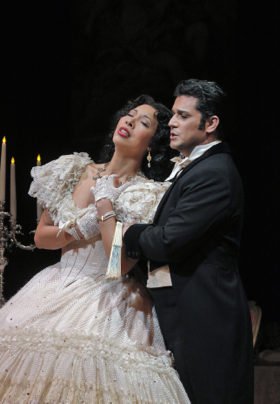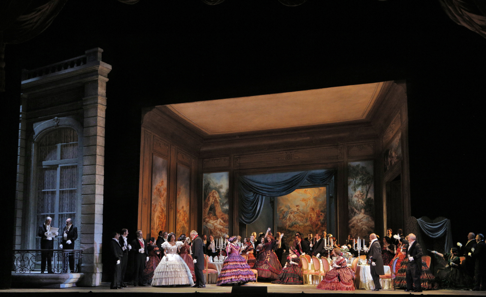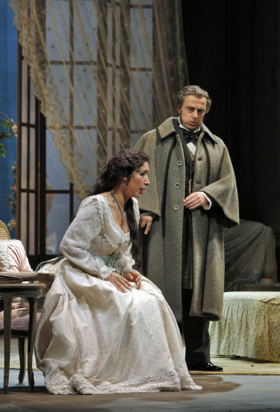
12 Jun 2014
La Traviata in San Francisco
La Traviata has hit the stage at San Francisco Opera every three to five years (even annually in some periods) since 1924. Surprises have been rare.
English Touring Opera are delighted to announce a season of lyric monodramas to tour nationally from October to December. The season features music for solo singer and piano by Argento, Britten, Tippett and Shostakovich with a bold and inventive approach to making opera during social distancing.
This tenth of ten Live from London concerts was in fact a recorded live performance from California. It was no less enjoyable for that, and it was also uplifting to learn that this wasn’t in fact the ‘last’ LfL event that we will be able to enjoy, courtesy of VOCES8 and their fellow vocal ensembles (more below …).
Ever since Wigmore Hall announced their superb series of autumn concerts, all streamed live and available free of charge, I’d been looking forward to this song recital by Ian Bostridge and Imogen Cooper.
Although Stile Antico’s programme article for their Live from London recital introduced their selection from the many treasures of the English Renaissance in the context of the theological debates and upheavals of the Tudor and Elizabethan years, their performance was more evocative of private chamber music than of public liturgy.
Evidently, face masks don’t stifle appreciative “Bravo!”s. And, reducing audience numbers doesn’t lower the volume of such acclamations. For, the audience at Wigmore Hall gave soprano Elizabeth Llewellyn and pianist Simon Lepper a greatly deserved warm reception and hearty response following this lunchtime recital of late-Romantic song.
For this week’s Live from London vocal recital we moved from the home of VOCES8, St Anne and St Agnes in the City of London, to Kings Place, where The Sixteen - who have been associate artists at the venue for some time - presented a programme of music and words bound together by the theme of ‘reflection’.
'Such is your divine Disposation that both you excellently understand, and royally entertaine the Exercise of Musicke.’
‘And there was war in heaven: Michael and his angels fought against the dragon; and the dragon fought and his angels, And prevailed not; neither was their place found any more in heaven … that old serpent … Satan, which deceiveth the whole world: he was cast out into the earth, and his angels were cast out with him.’
There was never any doubt that the fifth of the twelve Met Stars Live in Concert broadcasts was going to be a palpably intense and vivid event, as well as a musically stunning and theatrically enervating experience.
‘Love’ was the theme for this Live from London performance by Apollo5. Given the complexity and diversity of that human emotion, and Apollo5’s reputation for versatility and diverse repertoire, ranging from Renaissance choral music to jazz, from contemporary classical works to popular song, it was no surprise that their programme spanned 500 years and several musical styles.
The Academy of St Martin in the Fields have titled their autumn series of eight concerts - which are taking place at 5pm and 7.30pm on two Saturdays each month at their home venue in Trafalgar Square, and being filmed for streaming the following Thursday - ‘re:connect’.
The London Symphony Orchestra opened their Autumn 2020 season with a homage to Oliver Knussen, who died at the age of 66 in July 2018. The programme traced a national musical lineage through the twentieth century, from Britten to Knussen, on to Mark-Anthony Turnage, and entwining the LSO and Rattle too.
With the Live from London digital vocal festival entering the second half of the series, the festival’s host, VOCES8, returned to their home at St Annes and St Agnes in the City of London to present a sequence of ‘Choral Dances’ - vocal music inspired by dance, embracing diverse genres from the Renaissance madrigal to swing jazz.
Just a few unison string wriggles from the opening of Mozart’s overture to Le nozze di Figaro are enough to make any opera-lover perch on the edge of their seat, in excited anticipation of the drama in music to come, so there could be no other curtain-raiser for this Gala Concert at the Royal Opera House, the latest instalment from ‘their House’ to ‘our houses’.
"Before the ending of the day, creator of all things, we pray that, with your accustomed mercy, you may watch over us."
The doors at The Metropolitan Opera will not open to live audiences until 2021 at the earliest, and the likelihood of normal operatic life resuming in cities around the world looks but a distant dream at present. But, while we may not be invited from our homes into the opera house for some time yet, with its free daily screenings of past productions and its pay-per-view Met Stars Live in Concert series, the Met continues to bring opera into our homes.
Music-making at this year’s Grange Festival Opera may have fallen silent in June and July, but the country house and extensive grounds of The Grange provided an ideal setting for a weekend of twelve specially conceived ‘promenade’ performances encompassing music and dance.
There’s a “slide of harmony” and “all the bones leave your body at that moment and you collapse to the floor, it’s so extraordinary.”
“Music for a while, shall all your cares beguile.”
The hum of bees rising from myriad scented blooms; gentle strains of birdsong; the cheerful chatter of picnickers beside a still lake; decorous thwacks of leather on willow; song and music floating through the warm evening air.

La Traviata has hit the stage at San Francisco Opera every three to five years (even annually in some periods) since 1924. Surprises have been rare.
And unwelcomed. Take for instance the 2009 San Francisco installment which was the 2006 art deco version imported from L.A. Opera directed by Marta Domingo. Violetta, a flapper, arrived at the party in a Rolls Royce during the overture, and it was downhill from there even though the soprano was Anna Netrebko.
Just now in San Francisco there was a welcome surprise, and that was Verdi’s orchestral score made vividly present in moods and colors, rushes and hesitations, pianos and fortes, well, pianissimos and fortissimos. It was the high octane conducting of Nicola Luisotti that made Verdi’s first truly masterful score the star of the show. The pit was the sentient center of Verdi’s personal and deeply felt domestic tragedy.
Never mind that this intense emotional focus emanating from the seemingly inspired musicianship of a superb orchestra revealed Francesco Maria Piave’s (and one assumes Verdi’s) dramatic structure to be truly clumsy. Or that Luisotti’s ultimate acceleration missed the emotional beats of the opera’s final moments — the blow of the intense release was summarily trampled over — a not atypical Luisotti conclusion.

La Traviata, Act I. Photo by Cory Weaver, courtesy of San Francisco Opera
The reliable 1987 (twenty-seven years ago) San Francisco Opera production by John Copley was back on stage. It is definitely mid-nineteenth century in concept as required by Verdi, glowing in warm colors (the splendid lighting designed by Gary Marder). The wash of colors, the swish of lavish gowns, the brilliant red flash of the flamenco dancer, the weight of nineteenth century architecture were however at odds with the detail and precision emerging from the Luisotti pit, and the emotional depth of the score itself.
The cast was decidedly low octane, and intimidated by the conductor. The stage action by the principals was kept downstage center, looking not at each other while singing to one another but presentational, addressing the audience and most importantly remaining able to have direct eye contact with the conductor.
Soprano Nicole Cabell replaced the originally announced Bulgarian soprano Sonya Yoncheva as Violetta. Mlle. Cabell has previously proven herself a fine bel canto singer in San Francisco (Giulietta in Bellini’s I Capuleti ed i Montecchi) in an integrated production (musical and production elements were compatible). A fine singer and artist, here undirected, she struggled to dominate the stage as required of Violetta, and did not possess an energy or brilliance of tone to bring Violetta to vibrant life. She opted out of the optional E-flat in “Sempre Libera.”
Albanian tenor Saimir Pirgu has also proven himself in San Francisco as a bel canto singer (Tebaldo in Bellini’s I Capuleti ed i Montecchi). A fine singer and artist, vocally he cannot make the leap from easily fulfilling the demands of well-directed bel canto to the specific vocal and histrionic requirements of proto-realism roles (a larger, warmer voice and presence) or the higher powered vocal demands of mid- and late Verdi theater.

Nicole Cabell as Traviata, Vladimir Stoyanov as Germont. Photo by Cory Weaver, courtesy of San Francisco Opera
Bulgarian baritone Vladimir Stoyanov sang Germont. This esteemed artist possesses a quite beautiful voice, and more than Mlle. Cabell or Mr. Pirgu fulfilled the Luisotti musical vision. Yet he too seemed a too small vocal and histrionic presence on the War Memorial stage.
Conductor Nicola Luisotti brings very specific and very powerful musicianship to opera. San Francisco Opera has yet to build a production around his unique talent. One hopes this may one day happen.
Luisotti conducts the first six performances (through June 29). The remaining four July performances, including the July 5 performance beamed directly onto the gigantic scoreboard of AT&T Park (home of the Giants), have a different cast of principals and a different conductor. Opera-at-the-Ball Park is not to be missed. It may be the Traviata you want to see.
Michael Milenski
Casts and production information:
Violetta Valéry: Nicole Cabell; Alfredo Germont: Saimir Pirgu; Giorgio Germont: Vladimir Stoyanov; Flora Bervoix: Zanda Svede; Gastone: Daniel Montenegro; Baron Douphol: Dale Travis; Marquis D’Obigny: Hadleigh Adams; Doctor Grenvil: Andrew Craig Brown; Annina: Erin Johnson; Giuseppe: Christopher Jackson. Chorus and Orchestra of San Francisco Opera. Conductor: Nicola Luisotti. Original stage director: John Copley; Stage director: Laurie Feldman; Set design: John Conklin; Costume design: David Walker; Lighting design: Gary Marder; Choreographer: Yaelisa. San Francisco War Memorial Opera House, June 11, 2014.